Intravenous hypertonic NaCl acts via cerebral sodium-sensitive and angiotensinergic mechanisms to improve cardiac function in haemorrhaged conscious sheep
- PMID: 17640936
- PMCID: PMC2277202
- DOI: 10.1113/jphysiol.2007.139592
Intravenous hypertonic NaCl acts via cerebral sodium-sensitive and angiotensinergic mechanisms to improve cardiac function in haemorrhaged conscious sheep
Abstract
Acute NaCl loading as resuscitation in haemorrhagic hypovolaemia is known to induce rapid cardiovascular recovery. Besides an osmotically induced increase in plasma volume the physiological mechanisms of action are unknown. We hypothesized that a CNS mechanism, elicited by increased periventricular [Na(+)] and mediated by angiotensin II type 1 receptors (AT(1)), is obligatory for the full effect of hypertonic NaCl. To test this we investigated the cardiovascular responses to haemorrhage and subsequent hypertonic NaCl infusion (7.5% NaCl, 4 ml (kg BW)(-1)) in six conscious sheep subjected to intracerebroventricular (i.c.v.) infusion of artificial cerebrospinal fluid (aCSF; control), mannitol solution (Man; 75 mmol l(-1) [Na(+)], total osmolality 295 mosmol kg(-1)) or losartan (Los; 1 mg ml(-1), AT(1) receptor antagonist) at three different occasions. Man normalized (144 +/- 6 mmol l(-1), mean +/- s.d.) the increase in i.c.v. [Na(+)] seen after aCSF (161 +/- 2 mmol l(-1)). Compared with control, both Man and Los significantly (P < 0.05) attenuated the improvement in mean arterial blood pressure (MAP), cardiac index and mesenteric blood flow (SMBF) in response to intravenous hypertonic NaCl: MAP, rapid response +45 mmHg versus +38 mmHg (Man) and +35 mmHg (Los); after 180 min, +32 mmHg versus +21 mmHg (Man) and +19 mmHg (Los); cardiac index after 180 min, +1.9 l min(-1) (m(2))(-1) versus +0.9 l min(-1) (m(2))(-1) (Man) and +0.9 l min(-1) (m(2))(-1) (Los); SMBF rapid response, +981 ml min(-1) versus +719 ml min(-1) (Man) and +744 ml min(-1) (Los); after 180 min, +602 ml min(-1) versus +372 ml min(-1) (Man) and +314 ml min(-1) (Los). The results suggest that increased periventricular [Na(+)] and cerebral AT(1) receptors contribute, together with plasma volume expansion, to improve systemic haemodynamics after treatment with hypertonic NaCl in haemorrhagic hypovolaemia.
Figures
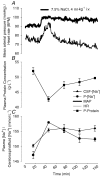

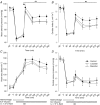
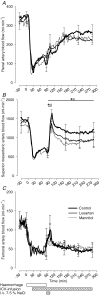
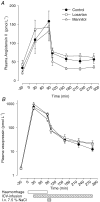
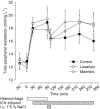
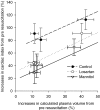
Similar articles
-
Increased resistance to haemorrhage induced by intracerebroventricular infusion of hypertonic NaCl in conscious sheep.Acta Physiol Scand. 1992 Jun;145(2):177-86. doi: 10.1111/j.1748-1716.1992.tb09353.x. Acta Physiol Scand. 1992. PMID: 1636446
-
Comparison between the effects on hemodynamic responses of central and peripheral infusions of hypertonic NaCl during hemorrhage in conscious and isoflurane-anesthetized sheep.Shock. 2006 Jul;26(1):77-86. doi: 10.1097/01.shk.0000215314.76370.c3. Shock. 2006. PMID: 16783202
-
Central losartan blocks natriuretic, vasopressin, and pressor responses to central hypertonic NaCl in sheep.Am J Physiol. 1998 Aug;275(2):R548-54. doi: 10.1152/ajpregu.1998.275.2.R548. Am J Physiol. 1998. PMID: 9688692
-
[Hypertonic solutions and intracranial pressure].Schweiz Med Wochenschr. 1996 Sep 28;126(39):1635-43. Schweiz Med Wochenschr. 1996. PMID: 8927967 Review. French.
-
Brain versus peripheral angiotensin II receptors in hypovolaemia: behavioural and cardiovascular implications.Clin Exp Pharmacol Physiol. 2000 May-Jun;27(5-6):437-42. doi: 10.1046/j.1440-1681.2000.03262.x. Clin Exp Pharmacol Physiol. 2000. PMID: 10831250 Review.
Cited by
-
Organ selective regulation of sympathetic outflow by the brain Angiotensin system.Curr Hypertens Rep. 2013 Aug;15(4):401-8. doi: 10.1007/s11906-013-0355-2. Curr Hypertens Rep. 2013. PMID: 23681510 Review.
-
The novel nitric oxide donor PDNO attenuates ovine ischemia-reperfusion induced renal failure.Intensive Care Med Exp. 2017 Dec;5(1):29. doi: 10.1186/s40635-017-0143-4. Epub 2017 Jun 9. Intensive Care Med Exp. 2017. PMID: 28600797 Free PMC article.
-
Adverse effects of hemorrhagic shock resuscitation with stored blood are ameliorated by inhaled nitric oxide in lambs*.Crit Care Med. 2013 Nov;41(11):2492-501. doi: 10.1097/CCM.0b013e31828cf456. Crit Care Med. 2013. PMID: 23887236 Free PMC article.
-
Role of Renal Sympathetic Nerve Activity in Volatile Anesthesia's Effect on Renal Excretory Function.Function (Oxf). 2021 Aug 20;2(6):zqab042. doi: 10.1093/function/zqab042. eCollection 2021. Function (Oxf). 2021. PMID: 35330795 Free PMC article.
References
-
- Andersson B, Eriksson L, Fernandez O, Kolmodin CG, Oltner R. Centrally mediated effects of sodium and angiotensin II on arterial blood pressure and fluid balance. Acta Physiol Scand. 1972;85:398–407. - PubMed
-
- Andersson B, Jobin M, Olsson K. A study of thirst and other effects of an increased sodium concentration in the 3rd brain ventricle. Acta Physiol Scand. 1967;69:29–36. - PubMed
-
- Barbosa SP, Camargo LA, Saad WA, Renzi A, Luca Junior LA, Menani JV. Lesion of the anteroventral third ventricle region impairs the recovery of arterial pressure induced by hypertonic saline in rats submitted to hemorrhagic shock. Brain Res. 1992;587:109–114. - PubMed
-
- Blair-West JR, Burns P, Denton DA, Ferraro T, McBurnie MI, Tarjan E, Weisinger RS. Thirst induced by increasing brain sodium concentration is mediated by brain angiotensin. Brain Res. 1994;637:335–338. - PubMed
Publication types
MeSH terms
Substances
LinkOut - more resources
Full Text Sources
Medical
Research Materials
Miscellaneous

